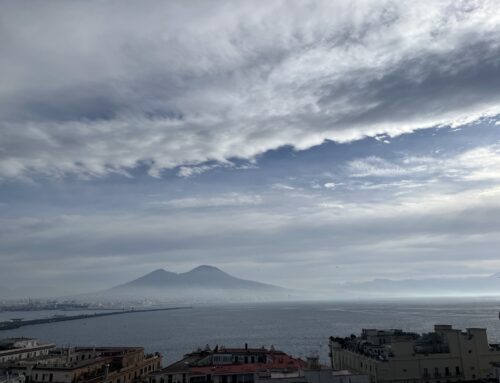Naples is a city rich in art, culture and history, there are hundreds of places of culture, churches, museums and archaeological excavations. If you are coming to Naples for the first time you cannot miss our list of 10 things to see absolutely, but trust us, after that you will return to Naples with even more desire to know it.
1. Sansevero Chapel and the Veiled Christ
Cappella Sansevero is one of the most important museums in Naples, it is a deconsecrated church located near Piazza San Domenico Maggiore. Masonic temple full of symbols, it is known throughout the world for the statue of the Veiled Christ by Giuseppe Sammartino and for the anatomical machines, two bodies, said to be of the servants of the Prince of Sansevero, where it is possible to study the human circulatory system. We advise you to buy tickets in advance because the queues are long and reservations are given priority.
Where: Via Francesco de Sanctis, 19/21, 80134 Naples
2. San Gregorio Armeno
Via San Gregorio Armeno is located in the historic center of Naples and is the real beating heart of the city, it is located between Via dei Tribunali and Spaccanapoli. It is one of the most representative streets of the city, in fact the shops where the artisans produce the typical Neapolitan nativity scene shepherds are open all year round. But tradition in Naples is always accompanied by innovation: the traditional figurines are accompanied by the public figures of the moment: from the Pope to Fedez, passing through Maradona and President Mattarella. You can visit San Gregorio Armeno at any time of the year, but let’s face it… Christmas is all the more magical! But in San Gregorio Armeno there are not only cribs: What to see in San Gregorio Armeno beyond the cribs
Where: Via S. Gregorio Armeno, 80138, Naples
3. Piazza Plebiscito and the Basilica of San Francesco di Paola
You cannot fail to take a walk in Piazza del Plebiscito, the living room of Naples. In the square. in front of the Royal Palace there are the large statues of the Kings of Naples and then in the center of the square there are two equestrian statues made by Antonio Canova and Antonio Calì. The two statues represent Charles III of Bourbon and his son Ferdinand I of the Kingdom of the Two Sicilies. Legend has it that if you try to walk around the square blindfolded, you will never be able to pass between the two statues. In Piazza Plebiscito is the Basilica of San Francesco di Paola, one of the symbols of neoclassicism in Naples, commissioned by Ferdinand I of the Two Sicilies. Find out what’s under the Plebiscite
Where: Piazza Plebiscito, 80132, Naples
4. Royal Palace of Naples
Palazzo Reale was designed in 1600 by Domenico Fontana and was commissioned by the Spanish Viceroy Fernando Ruiz de Castro. As soon as you enter the Palazzo you will be entranced by the Monumental Staircase (the story on instagram is a must!), where from the upper part of the monumental staircase you can admire the Teatro San Carlo, the Galleria Umberto I, the Church of San Ferdinando up to Castel Sant’Elmo and the Certosa di San Martino. At certain times it is also possible to visit the Hanging Gardens, commissioned by King Charles of Bourbon where you can admire a breathtaking view of Vesuvius. If you’re short on time, we recommend visiting the Romantic Gardens (bounded by the San Carlo Theater and the National Library), where access is free and you can take a walk and read a book in the shade of ancient trees.
Where: Piazza Plebiscito, 1, 80132, Naples
5. Waterfront and Castel dell’Ovo
If you are in Naples for a few days, another place not to be missed is the Lungomare. Dawn is the ideal time: the sun rises behind Vesuvius and the sea turns pink-orange, an incredible colour! But even at night the promenade is magical: many people stroll or eat pizza in front of the sea. Castel dell’Ovo is located on the seafront, more precisely on the islet of Megaride, where Partenope, the city of Naples, was born. The Castle owes its name to the legend of Virgil. It is said that in the basement of the castle the poet-magician hid an egg inside a crystal jug, all enclosed in an iron cage suspended from the ceiling. The balance of the islet of Megaride and of the whole city rests on the integrity of the egg: if the egg were to break, the city of Naples would be destroyed. From the terraces of the Castle you can admire the panorama of Naples from the sea. We also recommend taking a walk in the Borgo Marinaro at the foot of the Castle.
Where: Via Eldorado, 3, 80132 Naples
6. Terrace of Sant’Antonio in Posillipo, the thirteen descents
The terrace of Sant’Antonio in Posillipo is also known as the balcony over Naples; a romantic, sweet terrace that will make you fall in love with Naples and its colours. It is located in front of the Church of Sant’Antonio in Posillipo, one of the most sought-after churches by all married couples! From the terrace start “the thirteen descents” (or the 13 ramps), a road with 13 U-curves wanted by the viceroy Ramiro de Guzman duke of Medina, to facilitate the path of pilgrims who wanted to reach the Sanctuary.
Where: Via Minucio Felice, 13, 80122 Naples
7. The Art Stations (from Piazza Garibaldi to Piazza Vanvitelli – Toledo, Museum, University, Cathedral)
To get around in Naples you will surely find yourself using public transport, and Naples is the only city in the world that has made its line 1 a real museum. Almost all the stations, from Piazza Garibaldi to Piscinola are small museums with works mainly of contemporary art. The Art stations are the following: Vanvitelli, Materdei, Quattro Giornate, Salvator Rosa, Cavour, Dante, Toledo, Municipio and Università, and have been repeatedly awarded as the most beautiful stations in Europe. A special commendation goes to the Toledo station, in fact its architecture takes up the structure of the city of Naples: from the modern city you go down to the first floor to the ancient city where you will find some of the remains of the Roman city, to then arrive in the sea with its predominant colors . Simply magnificent!. The works of Metro 1 have also rediscovered the ancient port of Naples with also various Roman ships.
Where: Vanvitelli, Materdei, Quattro Giornate, Salvator Rosa, Cavour, Dante, Toledo, City Hall and University
Timetables and further information: website
8. Castel Sant’Elmo and the Belvedere of San Martino
Castel Sant’Elmo is located on the Vomero hill and dominates the whole city of Naples from above. You can get to the Castle with a walk in the elegant Vomero district or with the Montesanto funicular. The peculiarity of the Castle is its elongated star shape with 6 points which allows you to have a 360 ° view of Naples. In fact, from its ramparts you can admire the whole city and the whole gulf. On the terrace you will also find the 20th century museum with works from Futurism to today. After visiting the castle, you absolutely must get to the Belvedere di San Martino, a romantic terrace at any time of day or night. Always animated by boys in love and by children playing with the supersantos.
Where: Via Tito Angelini, 20/A, 80129 Naples
9. The underground paths
Naples has a parallel city in its subsoil, between tuff cavities, cisterns, aqueducts and catacombs. Under the streets you will walk on as a tourist, there is a real city. You are spoiled for choice on which one to visit, each neighborhood has different underground paths, each characterized by unique elements. Any examples? The submerged decumanus of the Basilica della Pietrasanta, Underground Naples in Piazza San Gaetano, Naples buried in San Lorenzo Maggiore, the Catacombs of San Gaudioso alla Sanità, the Catacombs of San Gennaro in Capodimonte and a ride on a raft under Piazza Plebiscito. In short, you absolutely cannot miss a walk in the subsoil of Naples!
Where: throughout Naples
Timetables and more information: Basilica della Pietrasanta, Underground Naples, Underground Naples, Catacombs of San Gaudioso and San Gennaro, Galleria Borbonica
10. National Archaeological Museum
The National Archaeological Museum of Naples is one of the most famous archaeological museums in Italy. It is mainly known for the Farnese collection, the Pompeian and Egyptian collections. It was born at the end of the 1500s as a Cavalry Barracks and later became a museum. The MANN is very active in the life of the city with many school projects, innovative exhibitions and many events open to the public, such as the Book Fair, free architecture meetings and children’s events.
Where: Piazza Museo, 19, 80135 Naples






